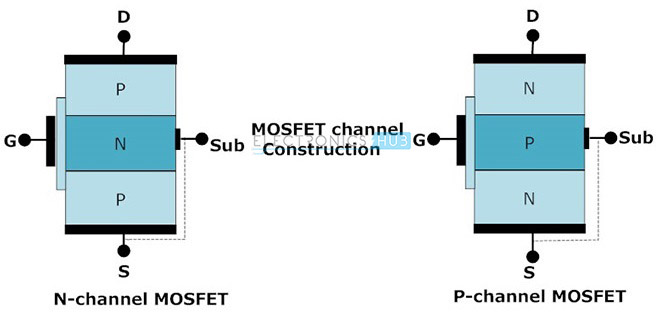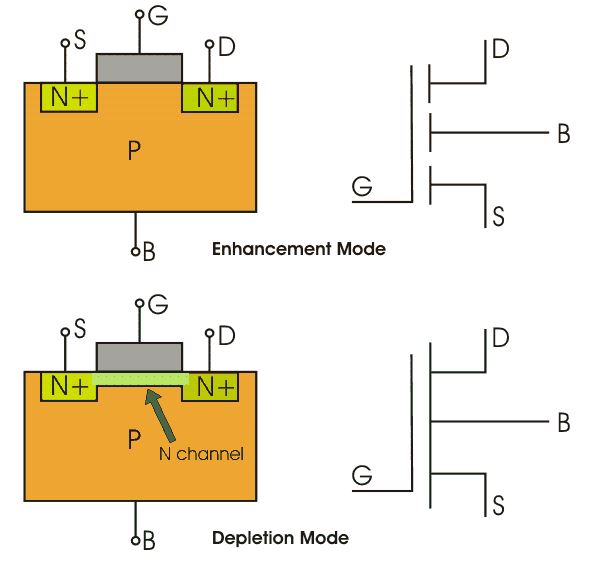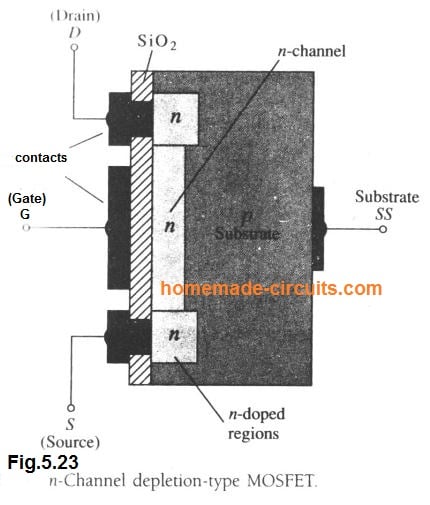MOSFET is a metal oxide semiconductor that is under the category of the field-effect transistor (FET). These transistors are widely used under the varieties of the applications relating to the amplification and the switching of the devices. Because of its fabrication MOSFET’s are available in smaller sizes. It consists of a source, drain, gate and the substrate of the transistor as its terminals. For the circuitry of analog or it be digital this one is the widely preferred transistor. Based on the variation at the depletion region width and the flow of the majority concentration of the carriers the working of the MOSFET is classified as depletion type and enhancement type.
- Enhancement Type Mosfet Notes
- N Channel Enhancement Mosfet Pdf
- Enhancement Type Mosfet
- Enhancement Type Of Mosfet Used
- Enhancement Type Of Mosfet Diagram
- Enhancement Type Mosfet Equations
- Figure-4 depicts drain characteristics and transfer curve of enhancement type of MOSFET (N-channel). As shown in the figure-4 minimum threshold voltage is needed for the flow of drain current to start. This type of FET is ideal for switching application. This is due to the fact that no gate voltage is needed to keep the device in 'off' state.
- Speaking of terminals, a MOSFET is typically a 3-terminal device, which are Gate (G), Source (S) and Drain (D) (even though there is a 4th terminal called Substrate or Body, it is usually not used in either input or output connection). MOSFET can be classified into Enhancement type MOSFET and Depletion type MOSFET.
- So, here in this type of MOSFET, basically the application of the control voltage enhances the number of charge carrier. And due to that, the channel is getting created. And that is why this type of MOSFET is known as the enhancement type of MOSFET. Working of then-channel enhancement type of MOSFET.
What is MOSFET?
A FET that is designed with the gate terminal being insulted from the substrate which is either the p-type or n-type material is called as Metal Oxide Semiconductor Field Effect Transistor. The Gate terminal which is a metal piece is insulated by material like silicon dioxide(Si02). The working of these MOSFETs depends upon the conduction of the charges through the channels based on the gate-source voltage.
Types of MOSFETs
Firstly based on the types of the channel it is classified as p-channel or n-channel MOSFETs. The presence of the channel in the transistor makes the MOSFET to operate into two different modes. If the channel exists and once the biasing is provided it starts to conduct then it is referred to as Depletion mode. Due to the biasing if the channel is created and then the conduction began then it is this referred to as Enhancement mode.
(1) Enhancement Mode
The application of the voltage makes the device to turn into ON mode known as Enhancement Mode. Generally, it is known for the characteristics similar to that of an open switch.
(2) Depletion Mode
MOSFET Types The classification of MOSFET based on the construction and the material used is given below in the flowchart. MOSFETs are of two classes: Enhancement mode and depletion mode. Each class is available as n-channel or p-channel, hence overall they tally up to four types of MOSFETs. Depletion and enhancement modes are two mutually exclusive modes of operation of a MOSFET. Here’s the structural diagram of a depletion-type MOSFET: And here’s the structural diagram of an enhancement-type MOSFET: As is evident, for a depletion-ty.
In this mode, the application of the voltage makes the device turn into OFF mode. Hence these mode characteristics are equivalent to the closed switch.
MOSFET Symbol
The symbol of the MOSFET consists of the terminals and the representation of the channels based on the condition of the biasing and the way channel reacts to it make the device to conduct the flow of the charge carriers. The direction of the arrow in the below symbols represents the direction of the flow of charge carriers. In N- channel type it flows outward towards the gate and in P- channel type it flows inward away from the gate terminal.
Symbols for N-channel Depletion and Enhancement Types
Enhancement Type Mosfet Notes
Structure of MOSFET
The structure of the MOSFET is highly dependent on the influence of the majority of the charge carriers. Hence it makes the designing of this type of structure as the quite difficult one in comparison with the structure of the JFET. The formations of the electric field in this MOSFET either enhancement or depletion is completely dependent on the voltage applied at the terminal gate which in turn depends on the channel . If it is p-channel the majority of the concentration of the carriers will be holes and for n-type the majority of the concentration of the carriers are electrons.
Based on the biasing applied at the terminal gate the transistor conducts. If there is no conducting voltage provided then, in that case, it will remain in non-conducting mode. So these are generally preferred in switching the devices because it makes the device to turn ON or OFF based on the biasing.
Threshold Voltage
The voltage that is applied between the gate and the source terminal upon which the device turns on or off is called threshold voltage and it is also referred to as the gate voltage.
N Channel Enhancement Mosfet Pdf
MOSFET Working
MOSFET working is highly dependent on the channel present in between the terminals. The presence of a p-type channel makes the transistor conduction possible due to its majority charge carriers referred to as holes. In the n-type channel, the transistor conductivity is based on their majority charge concentrations that are known as electrons.
(1) P-Channel
In this type of MOSFET, the source and drain are highly doped with a p-type material and they have very lightly doped n-type substrate. When the space between the drain and source are doped with a p-type impurities which becomes a channel between the source and the drain then it is a P-type depletion mode MOSFET and if the channel is formed between drain and source by the application of the gate voltage then it is P-type enhancement mode MOSFET.
Enhancement Type Mosfet
P-Channel Enhancement Mode Working
Here the device starts conducting when a negative voltage is applied to the Gate terminal. When a negative voltage is applied to all the holes which are minority carriers in the n-type moves toward the gate terminal. But on its way, some of them combine with the some of the electrons which are minority carriers in the p-type drain and source. But at a particular voltage known as the threshold voltage, the holes will be able to overcome the recombination resulting in the formation of the channel between the drain and the source. Under this condition when a negative voltage is applied to the drain terminal the device starts conducting. Since the channel formed here is of holes it is called as P-channel Enhancement MOSFET.

P-Channel Depletion Mode Working
In this Mode when the gate voltage is zero and when a negative voltage is applied between the drain and the source then the holes start moving towards the drain because of the negative voltage and the device starts conducting. When a positive voltage is applied to the Gate terminal then the holes in the p channel get pushed toward the N-type substrate and start the recombine with the electrons in the N-type substrate. As the voltage increase, the number of recombination increases and this results in the depletion of the charge carriers(holes) which results in the reduction of the drain current. At a particular positive voltage of the gate terminal, the device stops conducting this voltage is called the Pinch-off voltage. When a negative voltage is applied to the Gate terminal then the holes which are the minority carriers in the n-type substrate moves directly towards the channel, as a result, the Drain current starts increasing. As the negative voltage of the Gate terminal increases the Drain current also increases. This region is called the Enhancement region.
P-Channel Depletion MOSFET
The variation in the width of the regions impacts the conductivity of the transistor. This is the reason it is known as the depletion type of p-channel MOSFET.

(2) N-Channel
In an N-type MOSFET, the source and the drain have a highly doped N-type material and lightly doped P-type substrate. Based on the way the channel is formed these are also classified as enhancement and the depletion type of MOSFETs.

N-Channel Enhancement Mode Working
The positive polarity of the voltage is considered here because n-channel consists of the majority of the carriers as electrons. The operation is similar to p-type MOSFET except that the device starts conducting when a positive voltage applied to the gate terminal. As the positive voltage in the gate terminal is increased at a particular threshold voltage and a channel gets formed drain and source. Under this condition, if a positive voltage is applied between the drain and source the device starts conducting.
N-Channel Depletion Mode Working
This mode of operation is similar to the P-type depletion-mode except that the drain to source terminal should be forward biased and a positive voltage should be applied to the Gate terminal for the current to flow from the drain to source. When a negative voltage is applied the major charge carriers get repelled towards the substrate and combines with the electrons resulting in the depletion of the major charge carriers in the channel and so then there will be a reduction in the drain current. At a particular negative voltage, the drain current becomes zero. This voltage is called a pinch-off voltage. Hence this type of MOSFET is known as the N-channel Depletion mode MOSFET.
N-Channel Depletion MOSFET
The enhancement mode is known for its characteristics based on the applied voltage whereas depletion is based on the variation of its width of the depletion region.
MOSFET Characteristics
The characteristics of the MOSFET are also dependent on the depletion and the enhancement modes.
Enhancement Mode Characteristics
The most preferred transistor in MOSFET is of enhancement type. In this type, there is no conduction seen if the voltage at the gate and the source terminals are zero. As the voltage reaches the threshold the conductivity tends to increase.
Depletion Mode Characteristics
In this mode, the width of this depletion region is dependent on the applied voltage at the terminal gate. If it is increased in terms of the positive polarity considered then this increment can be seen in the width of the depletion region. This mode of a transistor is very rarely preferred during the design of the electronic circuitry.
MOSFET Applications
The applications of the MOSFET are vast in terms of the electronics
(1) The switching consequence of the devices based on the threshold value makes the MOSFET to work as a switch. Based on the channels the polarity of the biasing voltage may vary.
(2) By the application of the pulse-width modulation technique (PWM) the movement of the motors like DC, Stepper, etc… can get controlled.
(3) The amplifiers designed from these devices are used in the systems of the sounds as well as the radio frequency systems.
(4) The operation of the switching leads to the exploitation of the circuits of the chopper. In this, the value of the DC voltages is converted into the AC voltage by maintaining the same levels for the amplitudes.
(5) If the depletion region of the MOSFET is made in the configuration of the source follower then these circuits are utilized as the voltage regulators in the linear mode.
(6) As the sources that provide the constant value of the current these transistors are utilized.
(7) In order to drive the current or the value of the voltage at a high level, these are preferred in the circuits of oscillators or the mixers.
(8) These are the transistors with the impedance at the high level and possess the switching speed to be at a high level. Because of these characteristics, these are preferred for digital electronics.
(9) It is preferred in various types of systems of sound in the automobiles and the reinforced systems of the sound.
(10) These are preferred in the designing of the calculators.
Hence the above are some of the various applications of the MOSFET.

In this way, the types of MOSFETs are discussed. Though it has a complex design than JFET it is more preferred in analog and digital electronics. This has the features that are responsible for its tremendous growth in technology. Now based on the description can you anyone give an example of an application that used JFET but later replaced with the MOSFET?

There are two types of MOSFETS: depletion-type MOSFETs and enhancement-type MOSFETs.
Enhancement-type MOSFETS are MOSFETs that are normally off. When you connect an enhancement-type MOSFET, no current flows from drain to source when no voltage is applied to its gate. This is why it is called a normally off device.There is no current flow without a gate voltage.
However, if a voltage is applied to the gate lead of the MOSFET, the drain-source channel becomesless resistive. As the gate-source voltage increases more and more, the current flowing from drain to source increasesmore and more, until maximum current is flowing from drain to source.
An enhancement-type MOSFET is so named an enhancement device, because as the voltage to the gate increases, the current increases more and more, until at maximum level.
An enhancement-type MOSFET behaves very similar in action to a bipolar junction transistor.
The other type of MOSFET, a depletion-type MOSFET, has the complete opposite behavior. Depletion MOSFETsare normally on devices. They conduct current at maximum level when there is no voltage applied to the gate lead. with a depletion-type MOSFET, as you increase the gate-source voltage, the drain-source channel of the transistor becomes more resistive and the current flowing from drain to source decreases, and if the gate-source voltage reachesthe cutoff level, the current completely ceases to flow.
Enhancement Type Of Mosfet Used
Enhancement Type Of Mosfet Diagram
Enhancement Type Mosfet Equations
